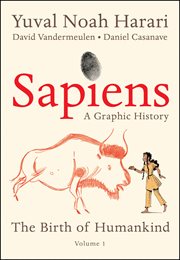Review by Booklist Review
Volume 1 in the graphic adaptation of 2011's best-selling Sapiens unpacks a huge swath of human history. An opening time line covers the creation of the universe and planet Earth before the book delves into the species that make up the human family, focusing primarily on Homo sapiens. Harari narrates as he and niece Zoe travel the world, visiting experts in biology, archaeology, and anthropology; reading Flintstones-style comics within a comic about Bill and Cindy Sapiens; and spectating at a trial of Homo sapiens as the main cause of animal extinction. The art style, with its exaggerated characters and dramatic action, recalls French and Belgian comics like Asterix or Gaston. Much attention is given to a cognitive revolution theory that aided early sapiens in communicating effectively in groups. Belief in stories, including not only novels but religion, government, and business law, is painted as the thing that separates us from animals, as well as from the other species in genus Homo. Meant for those who can appreciate jokes about Neanderthals being bad at PR or popes not passing down celibacy genes.
From Booklist, Copyright (c) American Library Association. Used with permission.
Review by Publisher's Weekly Review
Humanity learns its relatively insignificant place in the universe in this witty graphic adaptation by Vandermeulen and artist Casanave with historian Harari of his popular 2015 anthropological examination of the human race. "Humans were just weak, marginal creatures for a good two million years," claims Harari, who goes on to explain how humans jumped to the top of the food chain--causing ecological disaster along the way. Refreshingly, the co-creators don't treat the original text as a sacred calf, and take risks as they transform the sprawling scientific history into an accessible visual narrative. Yuval narrates most of the science as a story told to his young niece, but some concepts are conveyed as old-timey advertisements, jokey "Prehistoric Bill" Flintstones--style comic strips, an imagined TV talk show, and a high-stakes trial of "Ecosystem v. Homo Sapiens." While some panels are text-heavy, the storytelling and Casanave's rich line drawings keep things zipping along. This appealing first volume elucidates often misunderstood basics of human evolution (i.e., that until 50,000 years ago, there used to be at least six species of humans) while also unraveling knotty existential questions about humanity's role on this planet. Young science enthusiasts and adult philosophers alike will want to pick up this smart, snappy work. (Oct.)
(c) Copyright PWxyz, LLC. All rights reserved
Review by Kirkus Book Review
The professor and popular historian expands the reach of his internationally bestselling work with the launch of a graphic nonfiction series. In a manner that is both playful and provocative, Harari teams with co-creators adept at the graphic format to enliven his academic studies. Here, a cartoon version of the professor takes other characters (and readers) on something of a madcap thrill ride through the history of human evolution, with a timeline that begins almost 14 billion years ago and extends into the future, when humanity becomes the defendant in "Ecosystem vs. Homo Sapiens," a trial presided over by "Judge Gaia." As Harari and his fellow time travelers visit with other academics and a variety of species, the vivid illustrations by Casaneve and colorist Champion bring the lessons of history into living color, and Vandermeulen helps condense Harari's complex insights while sustaining narrative momentum. The text and illustrations herald evolution as "the greatest show on earth" while showing how only one of "six different human species" managed to emerge atop the food chain. While the Homo sapiens were not nearly as large, strong, fast, or powerful as other species that suffered extinction, they were able to triumph due to their development of the abilities to cooperate, communicate, and, perhaps most important, tell and share stories. That storytelling ultimately encompasses fiction, myth, history, and spirituality, and the success of shared stories accounts for a wide variety of historical events and trends, including Christianity, the French Revolution, and the Third Reich. The narrative climaxes with a crime caper, as a serial-killing spree results in the extinction of so many species, and the "Supreme Court of the future" must rule on the case against Homo sapiens. Within those deliberations, it's clear that not "being aware of the consequences of their actions" is not a valid excuse. An informative, breathless sprint through the evolution and consequences of human development. Copyright (c) Kirkus Reviews, used with permission.
Copyright (c) Kirkus Reviews, used with permission.

